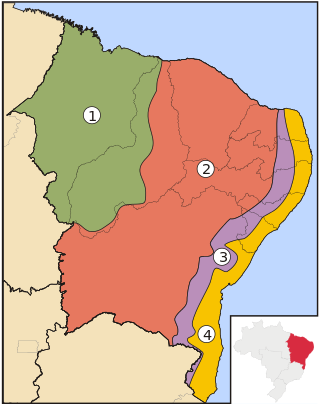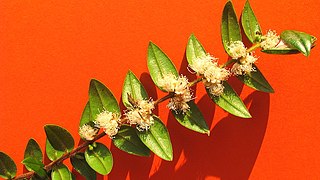
The Zona da Mata is the narrow coastal plain between the Atlantic Ocean and the dry agreste and sertão regions in the northeastern Brazilian states of Maranhão, Piauí, Rio Grande do Norte, Paraíba, Pernambuco, Alagoas, Sergipe and Bahia.

Jabuticaba, also spelled Jaboticaba, is the edible fruit of the jabuticabeira or Brazilian grapetree. The purplish-black, white-pulped fruit grows directly on the trunk of the tree, making it an example of 'cauliflory'. It is eaten raw or used to make jellies, jams, juice or wine. The tree, of the family Myrtaceae, is native to the states of Rio de Janeiro, Minas Gerais, Goiás and São Paulo in Brazil. Related species in the genus Myrciaria, often referred to by the same common names, are native to Brazil, Argentina, Paraguay, Peru and Bolivia.

Plinia is a genus of flowering plants in the myrtle family, Myrtaceae described by Linnaeus in 1753. It is native to Central and South America as well as the West Indies.

Día a Día con Raymond y Dagmar is a variety program on WKAQ-TV Telemundo Puerto Rico hosted by Raymond Arrieta, Dagmar and Gil Marie Lopez that airs weekdays from 1pm to 4pm AST on Telemundo Puerto Rico. The show premiered on January 15, 2007, and marked the return of Arrieta to television after having his long running show cancelled on rival station WAPA-TV.
Dyckia martinellii is a plant species in the genus Dyckia.
Neoregelia martinellii is a species of flowering plant in the genus Neoregelia. This species is endemic to Brazil.
Plinia spirito-santensis, commonly known as jabuticaba peluda de cruz or Grimal in the United States, is a species of plant in the family Myrtaceae. It is endemic to broad-leafed coastal forests, at altitude, in eastern Brazil. The plant is a semideciduous shrub or small tree which can grow to between 3 and 6 metres tall. It produces edible deep reddish-purple berries, up to 30mm in diameter. At the apex of the fruit there is a small cross, from which the name derives.
Plinia phitrantha, commonly known as jaboticaba branca or ibatinga , is a species of plant in the family Myrtaceae. It is endemic to the states of São Paulo and Minas Gerais in south-eastern Brazil. The tree grows to between 2 and 7 metres tall, and produces edible fruit, between 10 and 25mm in diameter, which is green in colour due to a lack of anthocyanins in the skin.
Plinia grandifolia, commonly known as jaboticaba graúda, is a species of plant in the family Myrtaceae. It is endemic to south-eastern Brazil, and is found almost exclusively in the under-story of the Atlantic Rainforest. The tree grows to between 4 and 8 metres tall, and produces dark-purple, edible fruit, between 15 and 25mm in diameter.

Plinia peruviana, commonly known as jabuticaba cabinho in Brazil, is a species of plant in the family Myrtaceae. It is endemic to central, South America.
Plinia coronata, commonly known as jaboticaba coroada, is a species of plant in the family Myrtaceae. It is endemic to south-eastern Brazil. The tree grows to between 4 and 12 metres tall, and produces purple, edible fruit, which is between 25 and 30mm in diameter.
Plinia rogersiana is a species of plant in the family Myrtaceae. It is endemic to the state of São Paulo in the south-east of Brazil. It is considered critically endangered, possibly extinct.
Plinia salticola, commonly known as dwarf mulchi or dwarf cambucá, is a species of plant in the family Myrtaceae. The tree is endemic to Costa Rica and Ecuador, grows to between 1 and 1.5 metre tall, and produces edible orange fruits.

Myrciaria strigipes, commonly known as cambucá da praia or cabeludinha da praia, is a species of plant in the family Myrtaceae. It is an evergreen shrub or small tree, endemic to Bahia and Espírito Santo in the east of Brazil. The plant grows up to between 4 and 9 metres tall, and produces edible yellowish fruits between 22 and 28mm in diameter. Consumed raw, the fruit has been described as tasting somewhere between Myrciaria glazioviana and Plinia cauliflora.
Plinia rivularis, commonly known as yva poroity, jaboticabarana, jabúriti, guapuriti, cambucá peixoto, jabuticaba de cacho, or piuna is a species of plant in the family Myrtaceae.
Plinia inflata, commonly known as mulchi in Ecuador or cambucá equatoriano in Brazil, is a species of plant in the family Myrtaceae. The tree is endemic to the Ecuadorian and Brazilian Amazon, grows to between 3 and 4 metres tall, and produces edible yellow-orange fruits. This plant has historically been mistaken for Eugenia subterminalis.
Plinia yasuniana is a species of plant in the family Myrtaceae. It is endemic to the understory of the Amazonian rainforest in Yasuni National Park in north-east Ecuador. The plant is a shrub that grows to between 1 and 3 metres tall. It produces cauliflorous, white flowers around 4 to 6mm long and edible, yellow fruits around 30mm in diameter, between August and November. It is named after the national park in which it was discovered in 2009.
Marcos Eduardo Guerra Sobral is a Brazilian botanist. Since 2009 he has been an adjunct professor of Botany at the Federal University of São João del-Rei. As of the end of 2020, Sobral has authored 79 publications and published 237 taxon names, particularly within the Eugenia, Myrcia, and Plinia genera of the family Myrtaceae.
Myrciaria rupestris is a species of plant in the family Myrtaceae. It is endemic to west Cuba. Plinia rubrinervis and Plinia rupestris were transferred to Myrciaria as this single species in 2014.




